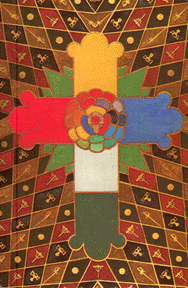| Tarot Arrangements according to: | ||||
| Tarot de Marseilles | Eliphas Levi | Golden Dawn | Aleister Crowley | Frater Achad |
Tarot de Marseilles Arrangement of Tarot Trumps
| Order | Title | Num. |
| 1 | Le Bateleur (The Juggler (The Magus)) | I. |
| 2 | La Papesse (The Female Pope (High Priestess)) | II. |
| 3 | L'Impératrice (The Empress) | III. |
| 4 | L'Empereur (The Emperor) | IIII. |
| 5 | Le Pape (The Pope) | V. |
| 6 | L'Amoureux (The Lover) | VI. |
| 7 | Le Chariot (The Chariot) | VII. |
| 8 | La Justice (Justice) | VIII. |
| 9 | L'Ermite (The Hermit) | VIIII. |
| 10 | La Roue de Fortune (The Wheel of Fortune) | X. |
| 11 | La Force (Strength) | XI. |
| 12 | Le Pendu (The Hanged Man) | XII. |
| 13 | La Morte (Death) | XIII. |
| 14 | La Temperance (Temperance) | XIIII. |
| 15 | Le Diable (The Devil) | XV. |
| 16 | La Maison Dieu (The House of God) | XVI. |
| 17 | L'Etoile (The Star) | XVII. |
| 18 | La Lune (The Moon) | XVIII. |
| 19 | Le Soleil (The Sun) | XVIIII. |
| 20 | Le Jugement (Judgement) | XX. |
| 21 | Le Monde (The World) | XXI. |
| 22 | Le Mat (The Fool) | (0) |
(Note: The method of writing Roman numerals was somewhat different from the accepted manner of today, using IIII in place of IV)
The exact origin of the Tarot remains obscure, but it is certain that the cards were in use around Italy and France as far back as the mid 14th century (~1500 A.D.)
The earliest Italian Tarot decks were unnumbered, but as early as 1490 card makers in Ferrara, Italy, began to place Roman numerals on the trumps, fixing them into a specific sequence. This practice was carried on by the early French card makers. It is uncertain which of the Italian trump sequences was adopted in what came to be known as the Tarot of Marseilles, but it is speculated that it may have been the ordering used by the Tarot card makers of Milan.
In 1781, Antoine Court de Gébelin published an essay on the esoteric history of the Tarot, expressing his belief that the Tarot originated in the Temples of Ancient Egypt, as 'the Book of Thoth'.
If we intended to announce that there exists contemporarily a work of the ancient Egyptians, one of their books which escaped the flames which devoured their superb libraries and which contained their purest doctrine on interesting subjects, everyone will be, no doubt, compelled to know such a precious and extraordinary book. If we added that this book was widely spread in a large part of Europe, that for several centuries it has been in the hands of everyone, the surprise would certainly be heightened. Would the surprise [shock] be compounded if we assured it was never suspected to be Egyptian, that we possessed it unknowingly, that no one had ever sought to decipher a sheet; that the fruit of exquisite wisdom is looked upon as an insignificant pile of extravagant trumps?
Would you not be inclined to believe we were toying with your credulity?
Such an Egyptian book exists.
It is unbelievably true; this Egyptian book, the last remains of their superb libraries, exists in our time; it is even so commonplace that no scholar has bothered to notice it; no one before us has ever suspected its prominent origin.
-- Antoine Court de Gébelin
Court de Gébelin accepted the traditional ordering of the trumps of his day, as it was codified in the numbering of the French pack of Tarot cards known as the Tarot of Marseilles, but he made comment or connection between the cards and the letters of the Hebrew alphabet and/or the Sepher Yetzirah.Would you not be inclined to believe we were toying with your credulity?
Such an Egyptian book exists.
It is unbelievably true; this Egyptian book, the last remains of their superb libraries, exists in our time; it is even so commonplace that no scholar has bothered to notice it; no one before us has ever suspected its prominent origin.
-- Antoine Court de Gébelin
Court de Gébelin renamed some of the trumps to give them a more Egyptian flavor, but he retained their Marseilles sequence. It was the usual custom to place the only trump that remained unnumbered, the Fool, at the end of the sequence, following XXI the World. Court de Gébelin declared that it should be numbered zero, because like the zero of mathematics, it has no value of its own, but only acquires value when added to other cards. This statement exerted profound influence over later occultists who wrote about the Tarot, such as Eliphas Levi, and Aleister Crowley
| Tarot Arrangements according to: | ||||
| Tarot de Marseilles | Eliphas Levi | Golden Dawn | Aleister Crowley | Frater Achad |






























